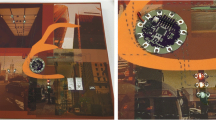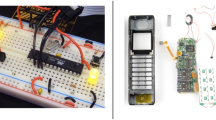Abstract
While circuitry lessons have traditionally been first introduced in late elementary school, they remain challenging conceptually for undergraduates in physics and engineering courses. Seeking to provide a higher quality and earlier introduction to circuitry learning for young children (ages 3–5), this paper investigates the affordances of utilizing the Squishy Circuits toolkit, a circuitry kit that combines circuit components and playdough, as a first introduction. Our study engaged 45 children across three nursery school classrooms in open-ended play with Squishy Circuits toolkits for seven sessions over a period of 2 weeks. Here, we focus on six children in one focal classroom in order to illustrate the concepts that children are developing during play and open exploration with the kits and a range of crafting materials. Findings indicated that the Squishy Circuits toolkit enabled children to explore concepts important to circuitry learning, including current flow, polarity, and connections. Additionally, analysis of whole class conversations before and after the circuitry explorations indicated significant gains in children’s ability to discuss circuitry concepts over the course of the study. Through individual case studies, we illustrate how children enacted these concepts through their play and how the transparency afforded by the toolkit make the big ideas of circuitry visible. This work serves to illustrate how very young children can successfully begin to engage with science topics commonly introduced in later elementary school when those topics are framed through play and discovery with transparent and malleable materials.

Similar content being viewed by others
Notes
In the Next Generation Science Standards (NGSS), circuitry is introduced in fourth grade, specific to the following academic standards:
4-PS3-2. Make observations to provide evidence that energy can be transferred from place to place by sound, light, heat, and electric currents.
4-PS3-4.Apply scientific ideas to design, test, and refine a device that converts energy from one form to another.* [Clarification Statement: Examples of devices could include electric circuits that convert electrical energy into motion energy of a vehicle, light, or sound; and, a passive solar heater that converts light into heat. Examples of constraints could include the materials, cost, or time to design the device.] [Assessment Boundary: Devices should be limited to those that convert motion energy to electric energy or use stored energy to cause motion or produce light or sound.]
References
Bruner, J. S. (1966). Toward a theory of instruction (Vol. 59). Cambridge: Harvard University Press.
Eisenberg, M., Eisenberg, A., Buechley, L., & Elumeze, N. (2006). Invisibility considered harmful: Revisiting traditional principles of ubiquitous computing in the context of education. In Wireless, mobile and ubiquitous technology in education, 2006. WMUTE’06. Fourth IEEE International Workshop on (pp. 103–110). IEEE.
Evans, J. (1978). Teaching electricity with batteries and bulbs. Phys Teach, 16(1), 15–22.
Fredette, N., & Lochhead, J. (1980). Student conceptions of simple circuits. Phys Teach, 18(3), 194–198.
Glauert, E. (2005). Making sense of science in the reception class. Int J Early Years Educ, 13(3), 215–233.
Glauert, E. B. (2009). How young children understand electric circuits: Prediction, explanation and exploration. Int J Sci Educ, 31(8), 1025–1047.
Johnson, S., & Thomas, A. (2010). Squishy circuits: A tangible medium for electronics education. In CHI’10 extended abstracts on human factors in computing systems (pp. 4099–4104). Atlanta: ACM.
Kafai, Y., & Peppler, K. (2014). Transparency reconsidered: Creative, critical, and connected making with E-textiles. In DIY citizenship: Critical making and social media (p. 179). Cambridge: MIT Press.
Karmiloff-Smith, A., & Inhelder, B. (1974). If you want to get ahead, get a theory. Cognition, 3(3), 195–212.
Lave, J., & Wenger, E. (1991). Situated learning: Legitimate peripheral participation. Cambridge: Cambridge University Press.
Masson, S., Potvin, P., Riopel, M., & Foisy, L. M. B. (2014). Differences in brain activation between novices and experts in science during a task involving a common misconception in electricity. Mind Brain Educ, 8(1), 44–55.
National Research Council. (2012). A framework for K-12 science education: Practices, crosscutting concepts, and core ideas. Washington, DC: The National Academies Press.
Osborne, R. (1981). Children’s ideas about electric current. New Zealand Science Teacher, 29, 12–19.
Osborne, R. (1983). Modifying children’s ideas about electric current. Res Sci Technol Educ, 1(1), 73–82.
Osborne, J., Black, P., Smith, M., & Meadows, J. (1991). Primary SPACE project research report: Electricity. Liverpool: Liverpool University Press.
Papert, S. (1980). Mindstorms: Children, computers, and powerful ideas. New York: Basic Books Inc.
Peppler, K., & Glosson, D. (2013a). Stitching circuits: Learning about circuitry through e-textile materials. J Sci Educ Technol, 22(5), 751–763.
Peppler, K., & Glosson, D. (2013b). Learning about circuitry with E-textiles in after-school settings. In M. Knobel & C. Lankshear (Eds.), The new literacies reader. New York: Peter Lang Publishing.
Peppler, K., Gresalfi, M., Tekinbaş, K. S., & Santo, R. (2014). Soft circuits: Crafting E-fashion with DIY electronics. Cambridge: MIT Press.
Peppler, K., Thompson, N., & Bender, S. (2015). “Nothing really for girls”: Examining perceived “gendered-ness” of circuitry learning toolkit. Presentation at 2015 Annual Meeting of AERA, Chicago, IL.
Scollon, R. (2001). Action and text: Towards an integrated understanding of the place of text in social (inter) action, mediated discourse analysis and the problem of social action. In R. Wodak & M. Meyer (Eds.), Methods of critical discourse analysis (pp. 113–139). Beverly Hills: Sage Publications.
Shepardson, D. P., & Moje, E. B. (1994). The nature of fourth graders’ understandings of electric circuits. Sci Educ, 78(5), 489–514.
Tiberghien, A., & Delacote, G. (1976). Manipulations et representations de circuits electriques simples: par des enfants de 7 à 12 ans. Revue française de pédagogie, 34, 32–34.
Vygotsky, L. S. (1978). Mind in society: The development of higher psychological processes. Cambridge: Harvard University Press.
Wohlwend, K. (2008). Play as a literacy of possibilities: Expanding meanings in practices, materials, and spaces. Language Arts, 86(2), 127–136.
Wohlwend, K. (2009). Mediated discourse analysis: Researching young children’s non-verbal interactions as social practice. J Early Child Res, 7(3), 228–243.
Funding
This study was funded by the National Science Foundation (Grant #1553398).
Author information
Authors and Affiliations
Corresponding author
Ethics declarations
Ethical Approval
All procedures performed in studies involving human participants were in accordance with the ethical standards of the institutional and/or national research committee and with the 1964 Helsinki declaration and its later amendments or comparable ethical standards.
Informed Consent
Informed consent was obtained from all individual participants included in the study.
Conflict of Interest
Author AnnMarie Thomas co-invented Squishy Circuits, and the Squishy Circuits company has made donations to her research lab to support undergraduate research. Authors Kylie Peppler, Karen Wohlwend, Naomi Thompson, and Verily Tan declare that they each have no conflict of interest.
Appendix
Appendix
A1: Pre- and post-discussion protocol
-
1.
What are electronics?
-
2.
What are wires and stuff? What is inside the wires and stuff?
-
3.
Do you know what electricity is? What makes it work?
-
4.
What is in a battery?
-
5.
[Hold up an electric object from around the classroom, while it’s off] Do you think this has electricity in it? [After they answer, turn it on] Do you think it has electricity now? How does it work? [Turning on and off] what is the difference?
-
6.
Do you know what a circuit is? Do you know what the parts are in a circuit?
-
7.
What are Squishy Circuits?
-
8.
How do you make a Squishy Circuit? What parts do you need to make a Squishy Circuit?
-
9.
What did you like about the Squishy Circuits?
-
10.
What did not you like about the Squishy Circuits?
-
11.
What would you change about the Squishy Circuits if you could?
-
12.
If you were to take Squishy Circuits to another classroom, what favorite thing would bring?
-
13.
What did you learn?
Rights and permissions
About this article
Cite this article
Peppler, K., Wohlwend, K., Thompson, N. et al. Squishing Circuits: Circuitry Learning with Electronics and Playdough in Early Childhood. J Sci Educ Technol 28, 118–132 (2019). https://doi.org/10.1007/s10956-018-9752-2
Published:
Issue Date:
DOI: https://doi.org/10.1007/s10956-018-9752-2




